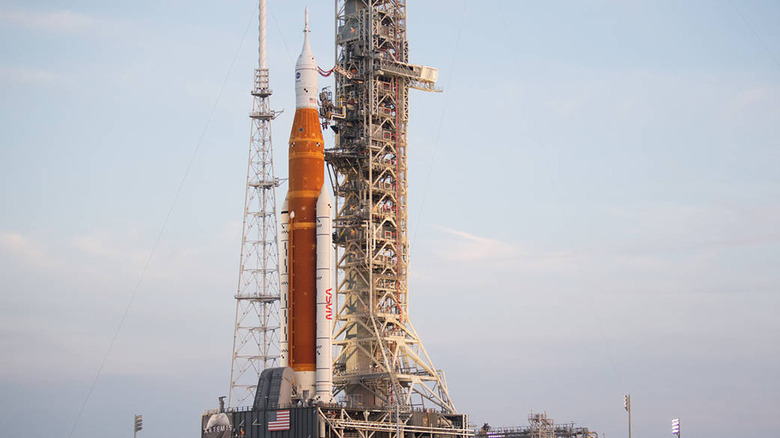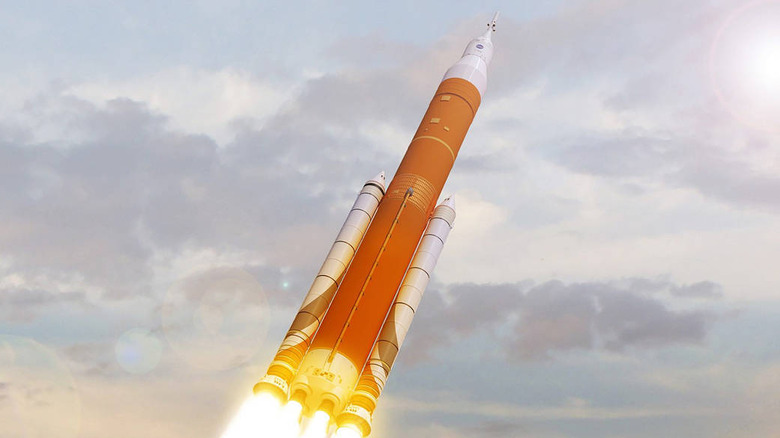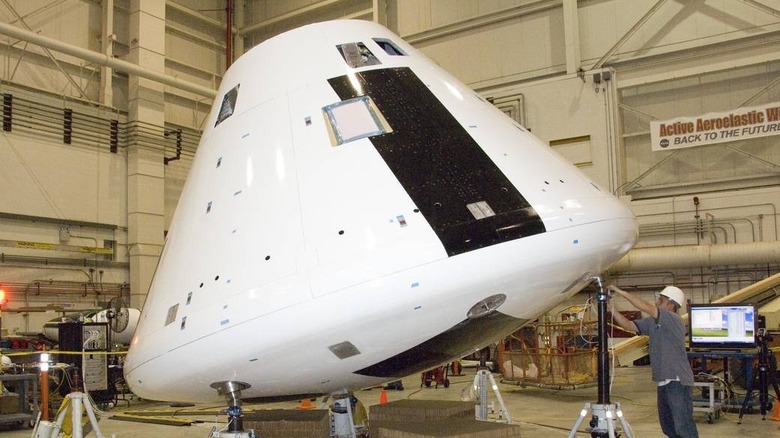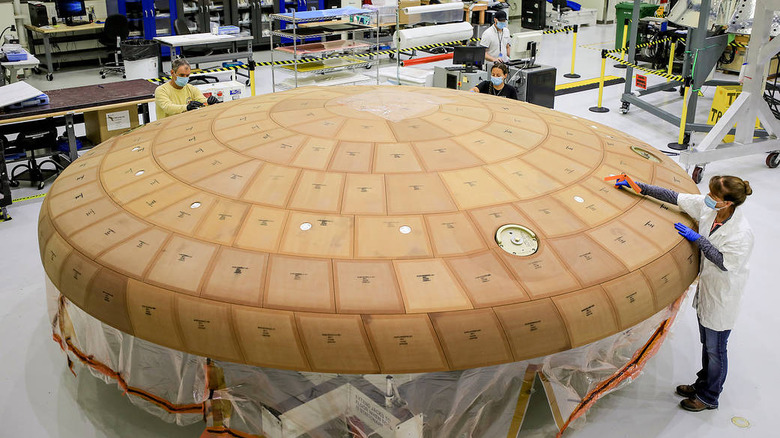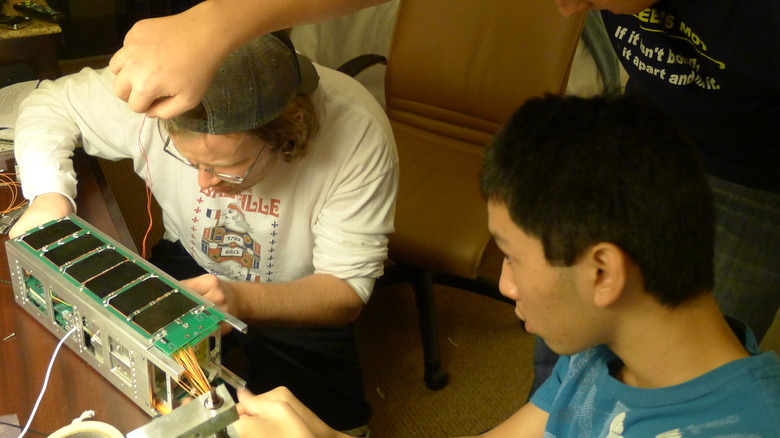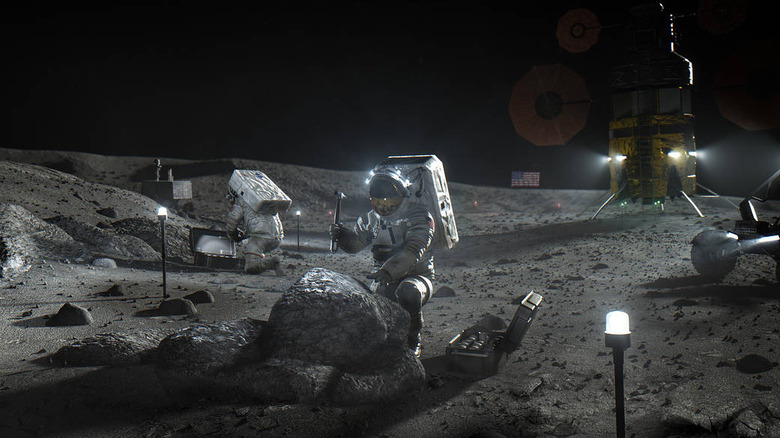What Is The Science Mission Of NASA's Upcoming Artemis I Launch?
It has been almost 50 years since an ambassador of humanity has walked on the surface of the moon. And although we set aside our ambition to walk among the barren craters of our closest celestial neighbor, we didn't stop reaching for the stars. In the years since Eugene Cernan and Harrison Schmitt left the lunar surface in 1972, we've explored the solar system from the center to its farthest edges and beyond.
We're not just exploring farther — we're now exploring more often, as 2021 had more successful space launches than any year in history (via The Hill). This bounty of rocket launches is fueled in part by the growing number of economic opportunities in space being chased not just by the ambitions of famous space billionaires but also by national governments. In fact, NASA hasn't been shy about its intentions to expand the commercial opportunities of space exploration. One of its strategic objectives for 2022 is to "develop a human spaceflight economy enabled by a commercial market." And one of the places it's looking to develop an economy is on the moon with the upcoming Artemis missions. But before we can go back to the moon, we have to test the systems that will get us there, which started at the end of August 2022 with the launch of Artemis I.
To loose the bonds of Earth
Low-Earth orbit is generally considered 1,200 miles or less from the surface of the Earth. Since the end of the Apollo program in the early 1970s, it's the furthest anyone has been into space (via The Washington Post). If we want to go further, we're going to need to use a bigger rocket, and that's where the space launch system (SLS) comes in. The launch, which could be as soon as September 2, 2022, will be the first time the SLS leaves the ground, and the Artemis I mission will be the first time it's fully tested (via Fortune). There's a lot riding on the SLS. It's the largest launch vehicle NASA has ever produced, and it's counting on the rocket system to enable not just trips to the moon, but trips to Mars as well (via NASA).
And NASA needs to get this launch right. We first began spending money on the SLS back in 2011. Since then, the U.S. has invested over $20 billion in getting it designed and built (via The Planetary Society). Going forward, each launch is going to carry a $4 billion price tag (per Ars Technica). If something goes wrong with the SLS, Congress might not be willing to pay for another one, setting manned space exploration back by decades.
To the moon and back
Perched atop more than 200 feet of rocket is the Orion spacecraft that will eventually carry humans to the moon. The most crucial part of Orion's future missions is to keep its passengers alive for the duration of their trip. To that end, the Artemis program's maiden flight will have a cargo of three mannequins in lieu of human passengers, each decked out in sensors to make sure that Orion can protect its passengers in the upcoming crewed missions. One "male" mannequin will be decked out in the space suit that future crew members will be wearing during launch and reentry and will be equipped with radiation sensors. Its seat will also be equipped with vibration sensors and accelerometers to measure the stress a human passenger will be subjected to (via Space.com).
The other two "female" mannequins will be used to study radiation exposure in depth. The mannequins will be outfitted with nearly 1,500 radiation sensors to get a granular understanding of how deep-space radiation could affect the body (via German Aerospace Center). One of the mannequins will be wearing an experimental vest designed to mitigate radiation exposure — an AstroRad vest. Artemis I provides a unique opportunity to test this kind of technology since it's impossible to simulate the rigors of deep space on Earth or in low-Earth orbit (via NASA).
It's going to get hot
Arguably more important than surviving the bombardment of deep-space radiation is surviving the trip through Earth's atmosphere. Atmospheric reentry is dangerous because of the astronomical speeds of returning spacecraft. Human created objects returning from low-Earth orbit typically travel at around 17,500 miles per hour (via NASA). The friction between the thin atmosphere and the hypersonic object (approximately Mach 25) raises temperatures to around 3,000 degrees. When Orion returns from its trip around the moon, it will be traveling over 25,000 miles per hour, and its reentry temperature will be around 5,000 degrees (via Lockheed Martin).
Given that large parts of Orion are made out of aluminum (which melts at around 1,200 degrees), the heat shield that protects the craft on reentry is of critical importance for astronauts on future missions. The basic shape of Orion is modeled on the proven design of the Apollo crew module, which survived all of its reentries. The material used to make the heat shield is also the same as that used for Apollo 50 years ago. Although Orion has already had some testing with reentry, the Artemis I mission will be the first time it's tested in the same conditions that astronauts returning from the moon will face (via Space.com).
Big science, small satellite
Ten CubeSats will be tucked away on Orion. CubeSats are a relatively new class of satellite that provide a low-cost method of launching something into space. According to the Canadian Space Agency, they are used for everything from science and technology testing to educational, amateur, and commercial uses. At their smallest, they are 4 inches to a side and weigh about 2 pounds. There have been over 1,800 CubeSat launches since 2003.
Four of the small satellites will be used to collect data about the lunar surface. Three of them will remain in orbit using spectroscopy to scan the surface for valuable chemicals like water and hydrogen (via NASA). One of them — OMOTENASHI from the Japanese Aerospace Exploration Agency — will attempt a lunar landing to prove the feasibility of low-cost landers (via Space.com). Among the remaining satellites are two that will be using unique propulsion systems. Near-Earth Asteroid Scout will use a 925-square-foot solar sail to harness the propulsive power of the sun's light to propel it to a small asteroid orbiting Earth (from NASA). Team Miles is a CubeSat that will test a new water-based plasma propulsion system that its makers hope to make available as a modular component to future CubeSat engineers (via Miles Space).
What's next for Artemis?
If everything goes according to plan, Artemis II will launch in 2024 (via Space.com). This mission will have four crew members, make one trip around the moon, and return to Earth, all in about 10 days (via NASA). If all goes well with that mission (and there are no delays), NASA could launch Artemis III in 2025, which would be the first manned mission to return to the moon since 1972 (via National Geographic).
Unlike the Apollo missions, part of the goal of the Artemis program is to establish a long-term presence on the lunar surface. The first step in that plan is to establish a space station in orbit around the moon called Gateway that will serve as a hub for astronauts traveling to the moon. NASA plans to launch the first two Gateway modules this November aboard a SpaceX rocket (via NASA).
The best part (for space nerds, at least) is that the Artemis program and the trip to the moon is only the first act of what NASA is planning. The endgame is a trip to Mars. Testing new launch vehicles, studying how the human body reacts to space, and planning return trips from interplanetary space are all part of the incremental process of building up the foundation of knowledge and technology that will enable us to send human explorers to Mars (also from NASA).
